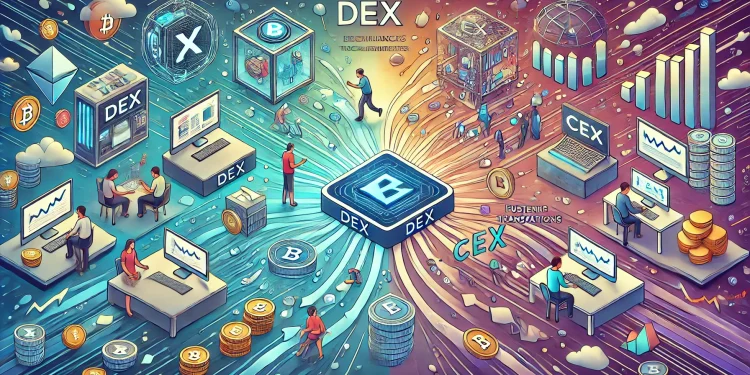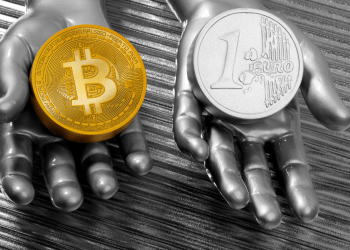In the rapidly evolving world of cryptocurrency trading, two primary types of exchanges have emerged: centralized exchanges (CEXs) and decentralized exchanges (DEXs). Both play crucial roles in the crypto ecosystem, but they operate on fundamentally different principles and exhibit distinct market dynamics. This comprehensive guide will explore the intricacies of DEXs and CEXs, comparing their features, benefits, challenges, and the unique market dynamics they create.
Understanding Centralized Exchanges (CEXs)
What are Centralized Exchanges?
Centralized exchanges are traditional platforms where cryptocurrency trading occurs under the oversight of a central authority. These exchanges act as intermediaries between buyers and sellers, maintaining order books, facilitating trades, and often providing custody services for users’ funds.
Key Features of CEXs
- Order Book Model: CEXs typically use an order book to match buy and sell orders.
- Custody of Funds: Users deposit funds into exchange-controlled wallets.
- KYC/AML Compliance: Most CEXs require identity verification for users.
- Fiat On/Off Ramps: Many CEXs offer direct fiat-to-crypto trading pairs.
- Advanced Trading Features: Often include margin trading, futures, and other complex financial products.
Popular Centralized Exchanges
- Binance
- Coinbase
- Kraken
- Gemini
- FTX
Understanding Decentralized Exchanges (DEXs)
What are Decentralized Exchanges?
Decentralized exchanges are peer-to-peer marketplaces where cryptocurrency trades occur directly between users, without the need for a central authority to facilitate the transactions. DEXs leverage smart contracts and blockchain technology to enable trustless trading.
Key Features of DEXs
- Automated Market Maker (AMM) Model: Many DEXs use liquidity pools and algorithms to determine asset prices and facilitate trades.
- Non-Custodial: Users retain control of their funds throughout the trading process.
- Permissionless: Anyone can access DEXs without needing to create an account or verify their identity.
- Smart Contract-Based: Trades are executed through smart contracts on the blockchain.
- Token Swaps: DEXs often specialize in token-to-token swaps within the same blockchain ecosystem.
Popular Decentralized Exchanges
- Uniswap
- SushiSwap
- PancakeSwap
- dYdX
- Curve Finance
Market Dynamics: CEXs vs. DEXs
1. Liquidity
Centralized Exchanges:
- Generally offer higher liquidity, especially for major cryptocurrency pairs.
- Liquidity is concentrated, making it easier to execute large trades without significant price slippage.
- Market makers and high-frequency traders contribute to tighter spreads.
Decentralized Exchanges:
- Liquidity varies widely between different DEXs and token pairs.
- Use liquidity pools, where users provide liquidity in exchange for rewards.
- May face challenges with liquidity for less popular or newly listed tokens.
- Liquidity is often fragmented across multiple DEXs.
2. Price Discovery
Centralized Exchanges:
- Traditionally considered the primary venue for price discovery.
- High trading volumes and diverse user base contribute to efficient price formation.
- Prices on CEXs often serve as reference points for the broader market.
Decentralized Exchanges:
- Price discovery mechanism differs, often using AMM models.
- Prices can deviate from CEXs, creating arbitrage opportunities.
- Increasingly playing a role in price discovery, especially for newly launched tokens.
3. Trading Volume
Centralized Exchanges:
- Dominate in terms of overall trading volume.
- Attract both retail and institutional traders.
- Offer a wide range of trading pairs, including fiat-to-crypto.
Decentralized Exchanges:
- Growing rapidly in trading volume, but still generally lower than major CEXs.
- Volume can spike during periods of high network congestion on CEXs.
- Often see higher volumes for newly launched tokens or during “yield farming” trends.
4. Market Efficiency
Centralized Exchanges:
- Generally more efficient due to higher liquidity and advanced trading features.
- Lower spreads and slippage for major trading pairs.
- Faster execution times for trades.
Decentralized Exchanges:
- Efficiency can vary widely between different DEXs and token pairs.
- May have higher slippage, especially for large trades or less liquid pairs.
- Transaction speeds depend on blockchain congestion and gas fees.
5. Asset Availability
Centralized Exchanges:
- Offer a curated selection of cryptocurrencies.
- New listings often cause significant market movements.
- Regulatory constraints may limit certain token listings.
Decentralized Exchanges:
- Offer a wider variety of tokens, including many not available on CEXs.
- Anyone can list a token, leading to a long tail of low-liquidity assets.
- Serve as the primary trading venue for many new and niche tokens.
6. Market Manipulation
Centralized Exchanges:
- Vulnerable to internal manipulation (e.g., wash trading, front-running by exchange operators).
- Regulatory oversight helps mitigate some forms of manipulation.
Decentralized Exchanges:
- Less susceptible to internal manipulation due to their transparent, on-chain nature.
- May be vulnerable to new forms of manipulation (e.g., flash loan attacks, sandwich attacks).
7. Regulatory Impact
Centralized Exchanges:
- Heavily influenced by regulatory decisions and compliance requirements.
- Geopolitical events can significantly impact their operations and user base.
Decentralized Exchanges:
- Generally less affected by traditional regulatory actions.
- Regulatory uncertainty remains a long-term concern for DEX development and adoption.
8. User Base and Adoption
Centralized Exchanges:
- Attract a broader user base, including crypto newcomers and institutional investors.
- Often serve as the entry point for new crypto users.
Decentralized Exchanges:
- User base tends to be more tech-savvy and crypto-native.
- Growing in popularity, especially among users prioritizing privacy and self-custody.
9. Innovation and Development
Centralized Exchanges:
- Innovation often focuses on user experience, new financial products, and regulatory compliance.
- Development is centralized and can be faster for certain features.
Decentralized Exchanges:
- Hotbed of financial innovation, particularly in DeFi (Decentralized Finance).
- Open-source nature encourages rapid iteration and community-driven development.
10. Network Effects
Centralized Exchanges:
- Benefit from strong network effects, where liquidity attracts more users, creating a virtuous cycle.
- Brand recognition and trust play significant roles in user acquisition.
Decentralized Exchanges:
- Network effects are growing, particularly within specific blockchain ecosystems.
- Interoperability protocols are enhancing network effects across different DEXs and chains.
The Evolving Landscape: Hybrid Models and Cross-Chain Solutions
As the crypto market matures, we’re seeing the emergence of hybrid models that aim to combine the strengths of both CEXs and DEXs:
Hybrid Exchanges
Some platforms are developing solutions that offer the user experience of a CEX with the non-custodial nature of a DEX. These hybrid exchanges aim to provide the best of both worlds, with features like:
- Off-chain order matching for speed
- On-chain settlement for security
- Fiat on/off ramps
- Advanced trading features
Cross-Chain DEXs
As blockchain interoperability improves, cross-chain DEXs are emerging to allow trading between assets on different blockchains. This development could significantly impact market dynamics by:
- Increasing liquidity across different blockchain ecosystems
- Reducing fragmentation in the DEX landscape
- Enabling new forms of cross-chain arbitrage
Impact on Traditional Finance
The evolution of crypto exchanges, both centralized and decentralized, is having a profound impact on traditional financial markets:
- 24/7 Trading: Unlike traditional stock exchanges, crypto markets never close, influencing expectations for other asset classes.
- Accessibility: Both CEXs and DEXs have dramatically lowered barriers to entry for global financial market participation.
- Innovation in Market Structure: Concepts like AMMs are being explored for traditional asset trading.
- Tokenization: The ease of creating and trading tokens is driving interest in tokenizing traditional assets.
- Regulatory Challenges: Regulators are grappling with how to approach these new market structures, potentially influencing future financial regulations.
Future Trends and Predictions
As we look to the future, several trends are likely to shape the dynamics of both CEXs and DEXs:
- Increased Institutional Participation: As regulatory clarity improves, we may see more institutional investors entering both CEX and DEX markets.
- Layer 2 Scaling Solutions: The adoption of Layer 2 solutions could dramatically improve the efficiency and reduce costs for DEX trading.
- DEX Aggregators: Tools that source liquidity from multiple DEXs may become increasingly important, potentially shifting market dynamics.
- Regulatory Adaptation: Both CEXs and DEXs will likely evolve to meet regulatory requirements while maintaining their core value propositions.
- AI and Machine Learning Integration: Advanced algorithms may play a larger role in liquidity provision and trading strategies on both types of exchanges.
- Enhanced Interoperability: Improvements in blockchain interoperability could lead to more seamless trading experiences across different networks.
- Mobile and User Experience Focus: Both CEXs and DEXs are likely to invest heavily in improving mobile trading experiences to capture a growing user base.
Challenges and Considerations
While both CEXs and DEXs have made significant strides, they still face several challenges:
Challenges for Centralized Exchanges
- Security Risks: CEXs remain attractive targets for hackers due to the large amounts of funds they hold.
- Regulatory Compliance: Keeping up with evolving global regulations is an ongoing challenge.
- User Trust: High-profile exchange hacks and scandals have eroded user trust in centralized platforms.
- Competition: Both from other CEXs and from the growing DEX sector.
Challenges for Decentralized Exchanges
- Scalability: Many DEXs face limitations in transaction speed and costs, especially on congested networks like Ethereum.
- User Experience: DEXs can be complex for non-technical users, potentially limiting adoption.
- Liquidity: Attracting and maintaining liquidity, especially for less popular trading pairs, remains a challenge.
- Smart Contract Risks: Vulnerabilities in smart contracts can lead to significant losses.
Conclusion
The coexistence of centralized and decentralized exchanges has created a rich and diverse ecosystem for cryptocurrency trading. Each type of exchange offers distinct advantages and faces unique challenges, contributing to the complex and dynamic nature of the crypto market.
Centralized exchanges continue to play a crucial role in providing liquidity, facilitating price discovery, and serving as a bridge between the traditional financial world and the crypto space. Their ability to offer advanced trading features and fiat on/off ramps makes them an important gateway for many users.
Decentralized exchanges, on the other hand, represent a paradigm shift in how we think about asset exchange. By eliminating intermediaries and leveraging blockchain technology, DEXs offer a level of transparency, security, and control that aligns closely with the ethos of cryptocurrencies. Their rapid growth and innovation, particularly in the DeFi space, suggest that they will play an increasingly important role in the future of finance.
As the market continues to evolve, we’re likely to see further innovations that blur the lines between CEXs and DEXs. Hybrid models, cross-chain solutions, and new technologies may emerge to address current limitations and offer users the best of both worlds.
For traders and investors, understanding the unique dynamics of both centralized and decentralized exchanges is crucial. Each offers different opportunities and risks, and the choice between them (or the use of both) will depend on individual needs, trading strategies, and risk tolerance.
Ultimately, the competition and coexistence of CEXs and DEXs drive innovation, improve user experiences, and contribute to the maturation of the cryptocurrency market as a whole. As this ecosystem continues to evolve, it has the potential to reshape not just how we trade digital assets, but how we think about financial markets and value exchange in the digital age.
FAQs
- What is the main difference between a centralized and decentralized exchange? Centralized exchanges are operated by a single entity and act as intermediaries, while decentralized exchanges facilitate peer-to-peer trading without a central authority, using smart contracts.
- Are decentralized exchanges safer than centralized exchanges? DEXs can be considered safer in terms of custody risk, as users retain control of their funds. However, they may have smart contract risks. CEXs may be vulnerable to hacks but often have more resources for security.
- Which type of exchange offers better liquidity? Generally, centralized exchanges offer better liquidity, especially for major cryptocurrency pairs. However, liquidity on DEXs is improving rapidly.
- Can I trade fiat currencies on decentralized exchanges? Most DEXs do not support direct fiat-to-crypto trading. Some are developing solutions, but currently, CEXs are the primary venues for fiat-to-crypto transactions.
- How do fees compare between CEXs and DEXs? Fee structures vary widely. CEXs typically charge a percentage of the trade value. DEX fees often include network (gas) fees, which can be high during periods of network congestion.
- Are there any geographical restrictions for using DEXs? DEXs are typically accessible globally without restrictions, unlike many CEXs which may have geographical limitations due to regulatory requirements.
- How does price discovery work on DEXs? Many DEXs use Automated Market Maker (AMM) models, where prices are determined by the ratio of assets in liquidity pools, rather than a traditional order book.
- Can institutional investors use decentralized exchanges? While DEXs are open to anyone, many institutional investors currently prefer CEXs due to regulatory compliance, advanced trading features, and higher liquidity.
- How do DEXs handle high-frequency trading? DEXs, especially those on slower blockchains, may not be suitable for high-frequency trading due to block confirmation times and gas fees. Some Layer 2 solutions are addressing this limitation.
- What is impermanent loss, and how does it affect DEX users? Impermanent loss is a risk for liquidity providers on DEXs, where the value of their deposited assets may decrease relative to simply holding the assets, due to price changes in the liquidity pair.















